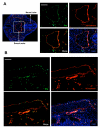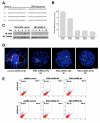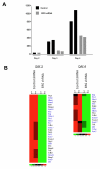ERG is required for the differentiation of embryonic stem cells along the endothelial lineage
- PMID: 20030844
- PMCID: PMC2803788
- DOI: 10.1186/1471-213X-9-72
ERG is required for the differentiation of embryonic stem cells along the endothelial lineage
Abstract
Background: The molecular mechanisms that govern stem cell differentiation along the endothelial lineage remain largely unknown. Ets related gene (ERG) has recently been shown to participate in the transcriptional regulation of a number of endothelial specific genes including VE-cadherin (CD144), endoglin, and von Willebrand's Factor (vWF). The specific role of the ETS factor ERG during endothelial differentiation has not been evaluated.
Results: ERG expression and function were evaluated during the differentiation of embryonic stem cells into embryoid bodies (EB). The results of our study demonstrate that ERG is first expressed in a subpopulation of vascular endothelial growth factor receptor 2 (VEGF-R2) expressing cells that also express VE-cadherin. During ES cell differentiation, ERG expression remains restricted to cells of the endothelial lineage that eventually coalesce into primitive vascular structures within embryoid bodies. ERG also exhibits an endothelial cell (EC)-restricted pattern during embryogenesis. To further define the role of ERG during ES cell differentiation, we used a knockdown strategy to inhibit ERG expression. Delivery of three independent shRNA led to 70-85% reductions in ERG expression during ES cell differentiation compared to no change with control shRNA. ERG knockdown was associated with a marked reduction in the number of ECs, the expression of EC-restricted genes, and the formation of vascular structures.
Conclusion: The ETS factor ERG appears to be a critical regulator of EC differentiation.
Figures






Similar articles
-
Gene expression analysis of embryonic stem cells expressing VE-cadherin (CD144) during endothelial differentiation.BMC Genomics. 2008 May 22;9:240. doi: 10.1186/1471-2164-9-240. BMC Genomics. 2008. PMID: 18498633 Free PMC article.
-
Antiinflammatory effects of the ETS factor ERG in endothelial cells are mediated through transcriptional repression of the interleukin-8 gene.Circ Res. 2009 May 8;104(9):1049-57. doi: 10.1161/CIRCRESAHA.108.190751. Epub 2009 Apr 9. Circ Res. 2009. PMID: 19359602 Free PMC article.
-
Endothelial Erg expression is required for embryogenesis and vascular integrity.Organogenesis. 2015;11(2):75-86. doi: 10.1080/15476278.2015.1031435. Organogenesis. 2015. PMID: 26061019 Free PMC article.
-
Regulation of endothelial homeostasis, vascular development and angiogenesis by the transcription factor ERG.Vascul Pharmacol. 2016 Nov;86:3-13. doi: 10.1016/j.vph.2016.05.003. Epub 2016 May 18. Vascul Pharmacol. 2016. PMID: 27208692 Free PMC article. Review.
-
The ETS Factor, ETV2: a Master Regulator for Vascular Endothelial Cell Development.Mol Cells. 2015 Dec;38(12):1029-36. doi: 10.14348/molcells.2015.0331. Epub 2015 Dec 21. Mol Cells. 2015. PMID: 26694034 Free PMC article. Review.
Cited by
-
The potential role of exosomal miRNAs and membrane proteins in acute HIV-infected people.Front Immunol. 2022 Aug 12;13:939504. doi: 10.3389/fimmu.2022.939504. eCollection 2022. Front Immunol. 2022. PMID: 36032099 Free PMC article.
-
Development and Application of Endothelial Cells Derived From Pluripotent Stem Cells in Microphysiological Systems Models.Front Cardiovasc Med. 2021 Feb 15;8:625016. doi: 10.3389/fcvm.2021.625016. eCollection 2021. Front Cardiovasc Med. 2021. PMID: 33659279 Free PMC article. Review.
-
ERG is a novel and reliable marker for endothelial cells in central nervous system tumors.Clin Neuropathol. 2015 May-Jun;34(3):117-27. doi: 10.5414/NP300817. Clin Neuropathol. 2015. PMID: 25881913 Free PMC article.
-
Caspase-8 modulates physiological and pathological angiogenesis during retina development.J Clin Invest. 2019 Dec 2;129(12):5092-5107. doi: 10.1172/JCI122767. J Clin Invest. 2019. PMID: 31454332 Free PMC article.
-
Ets family protein, erg expression in developing and adult mouse tissues by a highly specific monoclonal antibody.J Cancer. 2010 Oct 25;1:197-208. doi: 10.7150/jca.1.197. J Cancer. 2010. PMID: 21060730 Free PMC article.
References
Publication types
MeSH terms
Substances
Grants and funding
LinkOut - more resources
Full Text Sources
Other Literature Sources
Molecular Biology Databases
Miscellaneous

